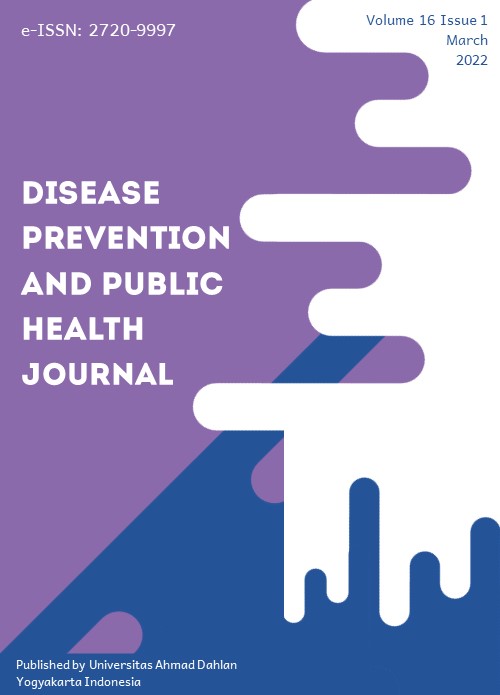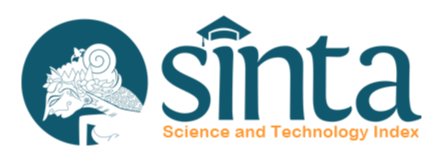Utilization of Puskesmas in Efforts to Prevent COVID-19 in Bengkulu City
DOI:
https://doi.org/10.12928/dpphj.v16i1.4494Keywords:
Utilization, Covid-19 prevention, Health center, PuskesmasAbstract
Background: Puskesmas as First Level Health Facilities (FKTP) plays a vital role during the Covid-19 pandemic in preventing and controlling the number of Covid-19 cases by anticipating, detecting, responding to events. However, at this time, the puskesmas are still underutilized by the community. The highest confirmed positive cases in Bengkulu City were in the Gading Cempaka District, with 990 cases. This study aimed to determine the variables related to the utilization of puskesmas in Bengkulu City. Methods: This research was quantitative research with a cross-sectional study design. Data collection was carried out by distributing questionnaires to respondents using an accidental sampling technique executed in March-August 2021. The research population was the entire community of Bengkulu City, with a sample of 110 respondents from the Gading Cempaka District, Bengkulu City. Data were analyzed by univariate to multivariate logistic regression. Results: The results show that 88 respondents (78.2%) have utilized the puskesmas, as many as 86 (78.2%) were female, 86 respondents (60.9%) belonged to the young age group, respondents with higher education were 73 respondents ( 66.4%), 73 respondents (66.4%) worked and as many as 79 respondents (71.8%) have income <UMP. The bivariate analysis results showed that the factors related to the utilization of the puskesmas (p<0.05) were variables of age, education, occupation, and income despite no relationship between gender, distance, knowledge, and family support (p>α). The results of the multivariate analysis showed that education was the dominant factor influencing the utilization of the puskesmas with (p-value = 0.010; B = 2.707; 95% CI = 1.892-118.569). Conclusion: The community has taken advantage of the puskesmas in terms of preventing Covid-19. The utilization of puskesmas is affected by age and education level.
References
2. Aisyah, D. N., Mayadewi, C. A., Diva, H., Kozlakidis, Z., Siswanto, & Adisasmito, W. (2020). A Spatial-Temporal Description of the SARS-Cov-2 Infections in Indonesia During the First Six Months of Outbreak. PloS one, 15(12), e0243703. https://doi.org/10.1371/journal.pone.0243703
3. Satgas Penanganan Covid-19 Kota Bengkulu. Data mediacenter Bengkulu Covid 2021. Kota Bengkulu; 2021.
4. Benneyan, J. C., White, T., Nehls, N., Yap, T. S., Aronson, M., Sternberg, S., Anderson, T., Goyal, K., Lindenberg, J., Kim, H., Cohen, M., Phillips, R. S., & Schiff, G. D. (2021). Systems Analysis of a Dedicated Ambulatory Respiratory Unit for Seeing and Ensuring Follow-up of Patients With COVID-19 Symptoms. The Journal of ambulatory care management, 44(4), 293–303. https://doi.org/10.1097/JAC.0000000000000390
5. Kotlar, B., Gerson, E., Petrillo, S., Langer, A., & Tiemeier, H. (2021). The Impact of the COVID-19 Pandemic on Maternal and Perinatal Health: A Scoping Review. Reproductive health, 18(1), 10. https://doi.org/10.1186/s12978-021-01070-6
6. Wanat, M., Hoste, M., Gobat, N., Anastasaki, M., Böhmer, F., Chlabicz, S., Colliers, A., Farrell, K., Karkana, M. N., Kinsman, J., Lionis, C., Marcinowicz, L., Reinhardt, K., Skoglund, I., Sundvall, P. D., Vellinga, A., Verheij, T. J., Goossens, H., Butler, C. C., van der Velden, A., … Tonkin-Crine, S. (2021). Transformation of Primary Care During the COVID-19 Pandemic: Experiences of Healthcare Professionals in Eight European Countries. The British journal of general practice: the journal of the Royal College of General Practitioners, 71(709), e634–e642. https://doi.org/10.3399/BJGP.2020.1112
7. Febriana, A., Mulyono, S., & Widyatuti, W. (2021). Family Support on Utilization of Adolescent Reproduction Health Service at the Area of Public Health Service (Puskesmas) of Martapura. Enfermeria clinica, 31 Suppl 2, S135–S138. https://doi.org/10.1016/j.enfcli.2020.12.008
8. Aizuddin, A. N., Abdul Jabar, S. W., & Idris, I. B. (2019). Factors Associated with Health Services Financier Among Temporary Sheltered Homeless in Urban Malaysia. BMC public health, 19(Suppl 4), 548. https://doi.org/10.1186/s12889-019-6871-5
9. Abiodun, O., Ovat, F., & Olu-Abiodun, O. (2019). Provider-Related Predictors of Utilization of University Health Services in Nigeria. Ethiopian journal of health sciences, 29(2), 239–250. https://doi.org/10.4314/ejhs.v29i2.11
10. Chauhan, B. G., & Jungari, S. (2021). Factors Affecting the Utilization of Maternal and Child Health Care Services in Tribal Dominated Population States of India. International quarterly of community health education, 42(1), 47–56. https://doi.org/10.1177/0272684X20972857
11. Morais, H., Albuquerque, M., Oliveira, R. S., Cazuzu, A., & Silva, N. (2018). Organizações Sociais da Saúde: Uma Expressão Fenomênica da Privatização da Saúde No Brasil [Social Healthcare Organizations: A Phenomenological Expression of Healthcare Privatization in Brazil]. Cadernos de saude publica, 34(1), e00194916. https://doi.org/10.1590/0102-311X00194916
12. Liu, Y. B., Liu, L., Li, Y. F., & Chen, Y. L. (2015). Relationship between Health Literacy, Health-Related Behaviors and Health Status: A Survey of Elderly Chinese. International journal of environmental research and public health, 12(8), 9714–9725. https://doi.org/10.3390/ijerph120809714
13. Curi, D., Figueiredo, A., & Jamelli, S. R. (2018). Factors Associated with the Utilization of Dental Health Services by the Pediatric Population: An Integrative Review. Ciencia & saude coletiva, 23(5), 1561–1576. https://doi.org/10.1590/1413-81232018235.20422016
14. Poss-Doering, R., Kunz, A., Pohlmann, S., Hofmann, H., Kiel, M., Winkler, E. C., Ose, D., & Szecsenyi, J. (2018). Utilizing a Prototype Patient-Controlled Electronic Health Record in Germany: Qualitative Analysis of User-Reported Perceptions and Perspectives. JMIR formative research, 2(2), e10411. https://doi.org/10.2196/10411
15. Nketiah-Amponsah, E., Alhassan, R. K., Ampaw, S., & Abuosi, A. (2019). Subscribers' Perception of Quality of Services Provided by Ghana's National Health Insurance Scheme - What Are the Correlates? BMC health services research, 19(1), 196. https://doi.org/10.1186/s12913-019-4023-3
16. Lee, M. Y., Lee, T. Y., & Lee, Y. C. (2020). Experiences of Family Resource Utilization Among Taiwanese Parents of Children with Developmental Delay. Journal of pediatric nursing, 53, e204–e210. https://doi.org/10.1016/j.pedn.2020.04.010
17. Roberts, T., Miguel Esponda, G., Krupchanka, D., Shidhaye, R., Patel, V., & Rathod, S. (2018). Factors Associated with Health Service Utilisation for Common Mental Disorders: A Systematic Review. BMC psychiatry, 18(1), 262. https://doi.org/10.1186/s12888-018-1837-1
18. Patel, M. R., TerHaar, L., Smith, A., Tariq, M., Worthington, K., Hinton, J., & Lichtenstein, R. (2020). Knowledge of Health Insurance Terms and the Affordable Care Act in Racially and Ethnically Diverse Urban Communities. Journal of immigrant and minority health, 22(3), 456–466. https://doi.org/10.1007/s10903-019-00924-3
19. Hadwiger, M., König, H. H., & Hajek, A. (2019). Determinants of Frequent Attendance of Outpatient Physicians: A Longitudinal Analysis Using the German Socio-Economic Panel (GSOEP). International journal of environmental research and public health, 16(9), 1553. https://doi.org/10.3390/ijerph16091553
20. McGrath C. (2019). Behavioral Sciences in the Promotion of Oral Health. Journal of dental research, 98(13), 1418–1424. https://doi.org/10.1177/0022034519873842
21. Surat Keputusan Gubenur. Upah Minimum Provisni Bengkulu. 2020.
22. Hamada, S., Takahashi, H., Sakata, N., Jeon, B., Mori, T., Iijima, K., Yoshie, S., Ishizaki, T., & Tamiya, N. (2019). Household Income Relationship with Health Services Utilization and Healthcare Expenditures in People Aged 75 Years or Older in Japan: A Population-Based Study Using Medical and Long-term Care Insurance Claims Data. Journal of epidemiology, 29(10), 377–383. https://doi.org/10.2188/jea.JE20180055
23. Khaki, J. J., & Sithole, L. (2019). Factors Associated with the Utilization of Postnatal Care Services Among Malawian Women. Malawi medical journal: the journal of Medical Association of Malawi, 31(1), 2–11. https://doi.org/10.4314/mmj.v31i1.2
24. Devkota, R., Khan, G. M., Alam, K., Sapkota, B., & Devkota, D. (2017). Impacts of Counseling on Knowledge, Attitude and Practice of Medication Use During Pregnancy. BMC pregnancy and childbirth, 17(1), 131. https://doi.org/10.1186/s12884-017-1316-6
25. Wolfenden, L., Williams, C. M., Kingsland, M., Yoong, S. L., Nathan, N., Sutherland, R., & Wiggers, J. (2020). Improving the Impact of Public Health Service Delivery ond Research: A Decision Tree to Aid Evidence-Based Public Health Practice and Research. Australian and New Zealand journal of public health, 44(5), 331–332. https://doi.org/10.1111/1753-6405.13023
26. Perera, S., & Dabney, B. W. (2020). Case Management Service Quality and Patient-Centered Care. Journal of health organization and management, ahead-of-print(ahead-of-print), 10.1108/JHOM-12-2019-0347. https://doi.org/10.1108/JHOM-12-2019-0347
27. Barrios-Ipenza, F., Calvo-Mora, A., Velicia-MartÃn, F., Criado-GarcÃa, F., & Leal-Millán, A. (2020). Patient Satisfaction in the Peruvian Health Services: Validation and Application of the HEALTHQUAL Scale. International journal of environmental research and public health, 17(14), 5111. https://doi.org/10.3390/ijerph17145111
28. Koulidiati, J. L., De Allegri, M., Souares, A., Ouedraogo, S., Hien, H., Robyn, P. J., & Brenner, S. (2018). Factors Associated with Effective Coverage of Child Health Services in Burkina Faso. Tropical medicine & international health: TM & IH, 23(11), 1188–1199. https://doi.org/10.1111/tmi.13140
29. Xu, M., Cheng, M., Gao, X., Wu, H., Ding, M., Zhang, C., Wang, X., Feng, X., Tai, B., Hu, D., Lin, H., Wang, B., Wang, C., Zheng, S., Liu, X., Rong, W., Wang, W., Xu, T., & Si, Y. (2020). Factors Associated with Oral Health Service Utilization Among Adults and Older Adults in China, 2015-2016. Community dentistry and oral epidemiology, 48(1), 32–41. https://doi.org/10.1111/cdoe.12497
30. Mao, W., Zhang, Y., Xu, L., Miao, Z., Dong, D., & Tang, S. (2020). Does Health Insurance Impact Health Service Utilization Among Older Adults in Urban China? A Nationwide Cross-Sectional Study. BMC health services research, 20(1), 630. https://doi.org/10.1186/s12913-020-05489-8
31. Kinney, A. R., Graham, J. E., Sharp, J., Hoffman, A., & Malcolm, M. P. (2021). The Relationship Between Fall Risk and Hospital-Based Therapy Utilization Is Moderated by Demographic Characteristics and Insurance Type. Archives of physical medicine and rehabilitation, 102(6), 1124–1133. https://doi.org/10.1016/j.apmr.2020.12.005
32. Noble, H., & Barrett, D. (2019). Health Promotion. Evidence-based nursing, 22(1), 14–16. https://doi.org/10.1136/ebnurs-2018-103031
33. Haikal, Ratih Pramitasari, Alvin Maulana Firza Yanuar, Nis Syifa’ur Rahma (2021). The Behaviour of Health Faculty Students Responding to Hoaxes Related Covid-19 on Social Media. Disease Prevention and Public Health Journal, 15 (2). https://doi.org/10.12928/dpphj.v15i2.3992
Downloads
Published
Issue
Section
License
Copyright (c) 2021 Universitas Ahmad Dahlan

This work is licensed under a Creative Commons Attribution-ShareAlike 4.0 International License.
Authors transfer the copyright and grant the Disease Prevention and Public Health Journal right of first publication with the work simultaneously licensed under a Creative Commons Attribution License (CC BY-SA 4.0) that allows others to share (copy and redistribute the material in any medium or format) and adapt (remix, transform, and build upon the material) the work for any purpose, even commercially with an acknowledgement of the work's authorship and initial publication in Disease Prevention and Public Health Journal. Authors are able to enter into separate, additional contractual arrangements for the non-exclusive distribution of the journal's published version of the work (e.g., post it to an institutional repository or publish it in a book), with an acknowledgement of its initial publication in Disease Prevention and Public Health Journal. Authors are permitted and encouraged to post their work online (e.g., in institutional repositories or on their website) prior to and during the submission process, as it can lead to productive exchanges, as well as earlier and greater citation of published work (See The Effect of Open Access).

This work is licensed under a Creative Commons Attribution-ShareAlike 4.0 International License.







